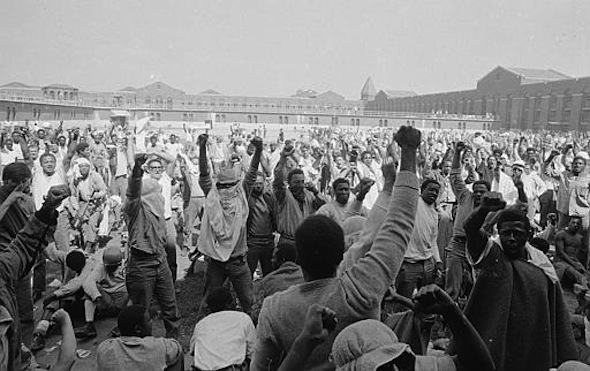When Bill Keller left The New York Times for The Marshall Project last year, he told the newspaper that the nonprofit venture was intended to be “a bit of a wake-up call to a public that has gotten a little numbed to the scandal that our criminal justice system is.”
That call rang this weekend with a biting, 7,000-word feature on prisoner abuse at the infamous Attica prison in western New York. Cross-published as the lead story in the Sunday Times, Tom Robbins’ piece recounts correctional officers’ ferocious beating of a defenseless inmate, George Williams, in 2011.
Criminal justice issues have indeed climbed the rungs of public consciousness in the past year, as police killings and subsequent protests in Ferguson, MO, and New York City have drawn national headlines. The vast majority of that coverage has focused on the racial tensions and bloodshed between law enforcement and civilians. Robbins’ story adds a new dimension, describing the issue of violence within prisons — guards on inmates, and vice versa — in harsh detail. And its historical spine, the 1971 Attica prison riot that left 43 people dead, acts as a foreboding warning throughout: If things get worse in the maximum security facility, history could very well repeat itself.
“In the immediate aftermath of the riot, there were many reforms that were instituted,” Robbins added on WNYC Monday. “But there was also a lot of slippage since then. Attica now is a maximum security prison — it’s got about 2,200 prisoners — and it’s a place where everybody is on alert and worried that there could be another riot.”

Inmates raise their hands in clenched fists in a show of unity during the 1971 Attica prison riot. (AP Photo)
Robbins interviewed reform advocates, guards, state officials, and at least three dozen current and former inmates. With the help of the nonprofit Correctional Association, he also culled material from years of prison records and court filings (Personnel records remain exceedingly difficult to obtain). That legwork alone is a public service. Important information is often buried amid mountains of such documents. The Marshall Project’s piece both extracts details from these reams of data and strings them together to paint a portrait of systemic violence.
What’s more, it addresses many of the reasons reform remains difficult. Union resistance prevents the closure of many facilities, even if they’re in poor condition. Most violent episodes are handled within prison walls, where correctional officers have more room to massage their accounts and inmates can be afraid to speak out. And punishment for correctional officers’ transgressions is notoriously weak.
That had the potential to change with Williams’ case. Four of his attackers were arraigned on gang assault charges in 2011, a first in New York State history. Charges on one of the guards have since been dropped. The three others pleaded guilty to a misdemeanor offense as part of a plea deal on Monday, a day after the story ran in the Times and the same day jury selection for their trial was set to begin. The correctional officers resigned from their jobs but will face no jail time, according to The Buffalo News.
It’s impossible to gauge whether Robbins’ reporting — to say nothing of the Times’ clout in the court of public opinion — influenced the decision. What is clear is that the guilty pleas affirm much of The Marshall Project’s exposé.
Great stories challenge the conventional wisdom, and the piece vividly illustrates how criminals, often dangerous on the street, can become vulnerable behind bars. The resulting culture of fear not only affects inmates under state supervision, but also threatens the guards tasked with supervising them.
David Uberti is a writer in New York. He was previously a media reporter for Gizmodo Media Group and a staff writer for CJR. Follow him on Twitter @DavidUberti.
